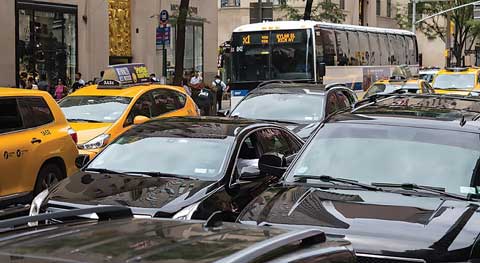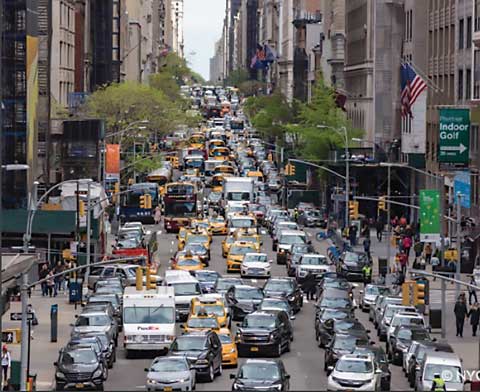

June 12, 2019
Extended cap on vehicle licenses and new cap on cars cruising empty will increase driver wages, reduce congestion
NEW YORK–Mayor de Blasio announced a new plan by the Taxi and Limousine Commission to extend the cap on For-Hire Vehicle licenses announced last year. He also announced a plan to create a second cap limiting how long FHV companies can let their vehicles cruise empty without passengers in the Manhattan core area below 96th Street.
Taken together, these caps are expected to cut congestion, increasing speeds in the evening rush hour by up to 10 percent. As companies reduce the time drivers cruise without a passenger, these policies have the potential to increase net driver hourly pay as much as 20 percent during the busiest times. They build on the unprecedented, first-in-the-country actions the City has taken to protect hardworking taxi drivers and rein in congestion. You can read the report that informed these policies here:
Improving efficiency and managing growth in New York’s For-Hire Vehicle Sector
FHV Congestion Study Report - NYC.gov or
https://www1.nyc.gov/assets/tlc/downloads/pdf/fhv_congestion_study_report.pdf
This comes after last year’s driver pay standard which increased earnings at the four major high volume FHV companies: Uber, Lyft, Via and Juno. The standard, which went into effect earlier this February, guarantees drivers a per-trip amount that will net at least $17.22 an hour. If they make less on any give trip, the app companies must pay the difference.
After the rule took effect, between February 1 and May 19 drivers earned an additional $172 million based on per-trip pay earned before and after the rules took effect. Before the standard went into effect, drivers only made the minimum pay standard on 4 percent of trips. Now they make that or more on 100 percent of trips – equivalent to an annual pay increase of $10,000. More than 80,000 FHV drivers are now benefiting from increased wages.
“For too long, app companies have taken advantage of hardworking drivers, choking our streets with congestion and driving workers into poverty,” said Mayor de Blasio. “That era will come to an end in New York City. Last year we took the first step, and this year we’re going further with new restrictions on how many empty cars these companies can have on our streets. That means higher wages for drivers and less congested streets for our city.”
Extending the Cap on FHV Licenses: The initial cap on FHV licenses was initially temporary set to run out in August 2019. Now, TLC will pursue rulemaking to extend this cap, with vigilant monitoring to ensure outer borough services remains fast and reliable. The cap will exclude wheelchair accessible vehicles and all electric vehicles to accelerate the creation of a greener, more accessible FHV fleet. Rules extending the cap will be noticed in June so it can take effect before the temporary cap expires in August.
New Cap on Cruising in the Manhattan Core: TLC will create a new rule that limits the amount of time an app company’s drivers can cruise in the core without passengers. Currently they cruise a remarkable 41 percent of the time without passengers, increasing congestion. This cap would require companies to reduce cruising to just 31 percent of the time vehicles are on the road. Strict penalties will ensure compliance, and TLC retains the right to suspend or revoke a company’s license to operate in New York City if they fail to comply.

This cap will be in effect weekdays 6 AM to 11 PM and weekends 8 AM to 11 PM. Companies will be required to decrease cruising to 36 percent by February 2020, and reach the 31 percent target by August 2020 in order to avoid sanction.
These caps complement other actions announced by the de Blasio Administration to help yellow taxi drivers this week, including:
The City is doing more to fight discrimination in the industry. TLC launched the Office of Inclusion five months ago. Since then, there has been robust outreach to civil rights groups, the driver industry, and the broader community.
TLC has assigned a dedicated data analyst to work with TLC’s Prosecution and IT divisions to review patterns of potential systematic discrimination in the FHV sector to inform TLC Prosecution enforcement. TLC is also looking at how to make the process of filing complaints more efficient, and will educate the public about how to make those complaints.
“The Mayor’s announcement today is welcome news for everyone who has ever sat in Midtown traffic in a bus, cab or car,” said DOT Commissioner Polly Trottenberg. “Having over 40 percent of FHVs in peak hours cruising empty on the City’s most congested streets is simply unsustainable. Along with other ambitious solutions like the Better Buses plan and congestion pricing, we look forward to working with TLC on implementing these new common sense rules for FHVs that will help get our City moving again.”
“The de Blasio Administration is fully committed to making transportation more accessible to New Yorkers and visitors with disabilities,” said MOPD Commissioner Victor Calise. “Extending the cap on the issuance of for-hire vehicles (FHV) licenses while continuing to have an exception for wheelchair accessible vehicles is a powerful incentive for FHV companies and potential drivers to increase the number of wheelchair accessible vehicles on the road to serve the needs of everyone.
MOPD is proud of the gains the City has made to increase the size of the wheelchair accessible FHV fleet thanks to the enactment of the TLC’s accessibility rules. We look forward to further enhancing accessible transportation options after today’s announcement.”
“With this new policy, New York City is holding companies accountable for the underutilization of drivers and oversupply of vehicles that have choked the city’s streets,” said Acting TLC Commissioner Bill Heinzen. “This innovative approach represents a major win for our hardworking drivers and the city as a whole. It shows how cities nationwide can take back control of their streets.”
Assembly Member Jeffrey Dinowitz said: “The arrival of e-hail car services such as Uber and Lyft completely upended the for-hire vehicle industry in New York City, bringing an enormous influx of new cars to our streets that had somehow escaped our agreed upon set of medallion regulations for yellow and green cabs.
The rise in e-hails has directly resulted in increased congestion from empty cars roving our neighborhoods as they wait for their next passenger pickup to be assigned to them. It is entirely logical that all for-hire vehicles should be regulated in the same manner, no matter whether they are summoned by app or on the street. It is unsustainable to allow unfettered access to our streets and potential passengers, and I am glad to Mayor de Blasio working to address this inequality among various FHV providers.”
“The extension of the for-hire vehicle cap is a necessary step to reduce congestion and protect New York’s drivers,” said Assembly Member David I. Weprin. “By extending the cap, we ensure parity between yellow cab taxis, who must adhere to limits of their own, and FHVs; while keeping congestion causing cars off our streets. I am grateful to Mayor Bill de Blasio for extending this cap and taking further steps to safeguard New York’s drivers.”
“Independent owner-drivers who were assured they were making a good investment, regulated by the City, are now enduring extraordinary financial hardships through no fault of their own,” said Council Member Mark Levine. “The moratorium on licensing fees is a tangible way to offer relief to these struggling drivers.
The reduced revenues are nominal for the City, especially as compared to the $850 million we took in from sales of inflated medallions during the bubble years. The City owes these drivers a great moral debt and the passage of this bill will be a way to start repaying that debt. I am glad that the Administration has made this commitment is joining my effort to support these drivers.”

“The extension of the For-Hire Vehicle cap is an important step to reduce congestion on our roads and to curb the financial crisis among professional drivers that has unfortunately led many to suicide,” said Council Member Adrienne Adams. “The continuation of the cap is a necessary pause on the unchecked growth of the For-Hire Vehicle industry and I thank Mayor De Blasio and the Taxi and Limousine Commission for taking this step.”
“A cap on new For Hire Vehicles was the first step in stabilizing incomes for drivers in poverty, debt and despair across the industry. And with the minimum payment rates that followed, Uber and Lyft drivers are finally able to see gains,” said Bhairavi Desai, Executive Director, New York Taxi Workers Alliance.
“The right to stable and livable income should be a standard in this industry – and that’s only possible with a permanent cap on FHVs. Uber and Lyft and their cohorts created a race to the bottom, filling our streets with so many vehicles that no driver could get enough fares to make a living. These companies have never had a supply problem, only an efficiency one, and when drivers are left cruising endlessly, they not only go without income, they pay for expenses out of pocket.
Uber and Lyft drivers are pushed out of the line for the next fare when there are too many cars, and yellow, green and livery drivers are drowned out. No driver wins when Uber and co over saturate our streets. That’s why Uber drivers across the country have called for vehicle caps. Now, our city is leading the way to protect full time livable incomes in the gig economy. We thank Mayor de Blasio for his leadership on this issue.”
“Uber and Lyft have for too long evaded their basic obligation to carry New Yorkers with disabilities. The city’s decision to maintain its cap on non-accessible vehicles makes it clear that their brand of old style discrimination won’t stand,” said Joe Rapport, Executive Director of the Brooklyn Center for Independence of the Disabled. “The next step is up to these companies who now have a chance to do the right thing and make the transition to full accessibility.”
“Since last year, for-hire vehicle companies and drivers have had a simple choice: If you want a new permit to carry passengers, you have to make sure you’re serving all New Yorkers, not just some of them,” said James Weisman, President and CEO of the United Spinal Association, a supporter of wheelchair accessibility. “That was a smart decision, and the mayor’s decision today to make the cap on non-accessible FHV vehicles permanent drives home the point.”
“We support the cap to restrict new for-hire vehicles to wheelchair-accessible vehicles,” said Edith Prentiss, chair of the Taxis For All Campaign, a coalition of disability groups. “Now, Uber, Lyft and other FHV companies must get the word out about being accessible in the same way they advertise and promote their non-accessible vehicles.”